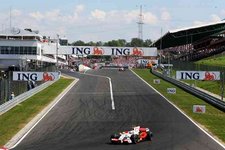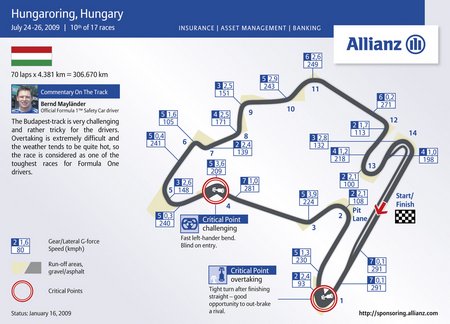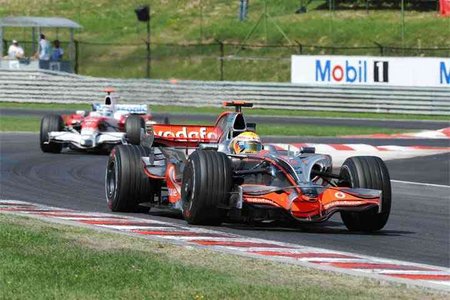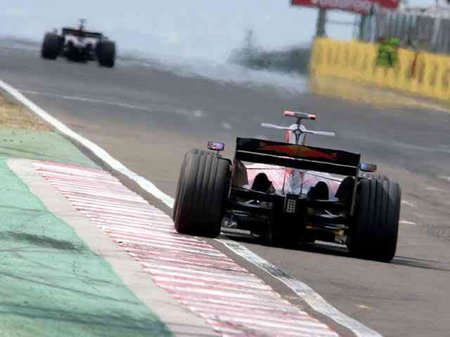 Round ten of the 2009 FIA Formula One World Championship takes the Formula One entourage to Budapest for the Hungarian Grand Prix. The
Round ten of the 2009 FIA Formula One World Championship takes the Formula One entourage to Budapest for the Hungarian Grand Prix. The
70-lap race is one of the most technically and physically demanding of the year, thanks to the twisting and tortuous nature of the 4.381km (2.722-mile) Hungaroring.
Track temperature has a big influence on car set-up at the Hungaroring. If it’s relatively cool, as was the case in 2006, the overriding handling characteristic of a car is understeer; if it’s hot, it is oversteer. Invariably the weather has been hot during the race’s 22-year history, so the engineers will arrive at the track this week expecting oversteer and will seek ways of protecting the rear tyres during the race. If the ambient temperature exceeds 30 degrees, the track’s lack of straights and low average speed could make cooling a concern.
The middle sector of the lap from Turn 4 through to the exit of Turn 11 gives the best indication of a car’s performance. The sector begins with a couple of slow corners, but ends with a very fast right-hander, which makes it hard to find a good balance. If a car is quick through this sector, you can expect it to be quick around the whole lap.

Vital Statistics:
- Circuit Length: 4.381km
- Race Distance: 306.458km (70 laps)
- Winner 2008: Heikki Kovalainen – McLaren-Mercedes
Circuit Guide:
[youtube]https://www.youtube.com/watch?v=5UitDjEMGrU&feature=PlayList&p=62A7DCA1926E2E00&index=26[/youtube]
Drivers Eye:
LEWIS HAMILTON (McLaren): “The Hungaroring is one of the most demanding circuits for drivers because you re busy throughout the entire lap. It s a bit like a kart circuit there are lots of twists and turns and the only place to relax is along the start/finish straight, which is quite short.
“It s also quite low-grip which makes overtaking particularly tricky. But I really enjoy the place I won here in 2007 and was on pole last year. It s a circuit that really rewards consistent, precise driving push too hard and you tend to lose rather than gain time. Given the potential we showed in Germany last weekend, I m hopeful of getting a result that demonstrates the improvement we ve made over the past few weeks.â€

ROBERT KUBICA (BMW Sauber): “Hungary is a very special Grand Prix for me. In 2006 I made my debut there, and there are always a lot of Polish fans as Budapest is quite close to Poland. Last year was amazing it was like being in Poland.
“The Hungaroring is very special, tricky and physically demanding. Driving the main straight is the only time you can recover. Almost over the entire track you leave one corner and immediately approach the next. Beyond that, it is very hot in Hungary, which makes it demanding for the driver and the tyres. As a lot of corners are quite bumpy, the car s balance will be another crucial factor.â€
NICK HEIDFELD (BMW Sauber): “I m very fond of the Hungaroring. The track suits me and I also have some good memories of racing there and achieving good results in the past. It was in Hungary in 1999 that I secured an early championship title in Formula 3000, and in 2006 and 2007 I was on the podium for the BMW Sauber F1 Team.
“We can generally expect high air temperatures in Hungary. That doesn t bother me from a physical point of view, although the races on this twisty circuit are always exhausting, and it could help us get the tyres into the temperature window to work well. One drawback in terms of grip, especially at the start of the weekend, is always the dust that blows onto the track from the surrounding landscape.â€

Technical Insight
WILLY RAMPF (Technical Director, BMW Sauber): “After Monaco, the Hungaroring has the lowest average speed of any circuit. One corner follows quickly after another and the start/finish straight is relatively short. Plus, no sooner is the sand cleared from the track one day than it is back again the next, and grip is consequently in short supply. Understeer is therefore a constant threat. As far as the car set-up is concerned, particular attention must be paid to the middle section with its variety of corner combinations. Another factor to consider is that the rear tyres are under heavy loads throughout the race.†Drivers eye
History and Background:
The track is situated about a 20-minute drive northeast of the centre of Budapest. Hungary s capital is also its largest city and the country s economic and cultural hub. The population of Budapest is around 1.7 million. It was above all the Danube as a trading route, as well as numerous hot springs, that were key to the city s prosperity. In 1873 the previously independent cities of Buda, Pest and Óbuda were united. The chain bridge (built 1839-49) linking hilly Buda on the west bank with the flat terrain of Pest in the east is as much a city landmark as the baroque royal castle on the Buda side.
With thanks to: Honda Racing F1 / Brawn GP, McLaren-Mercedes, BMW Sauber F1 Team.






